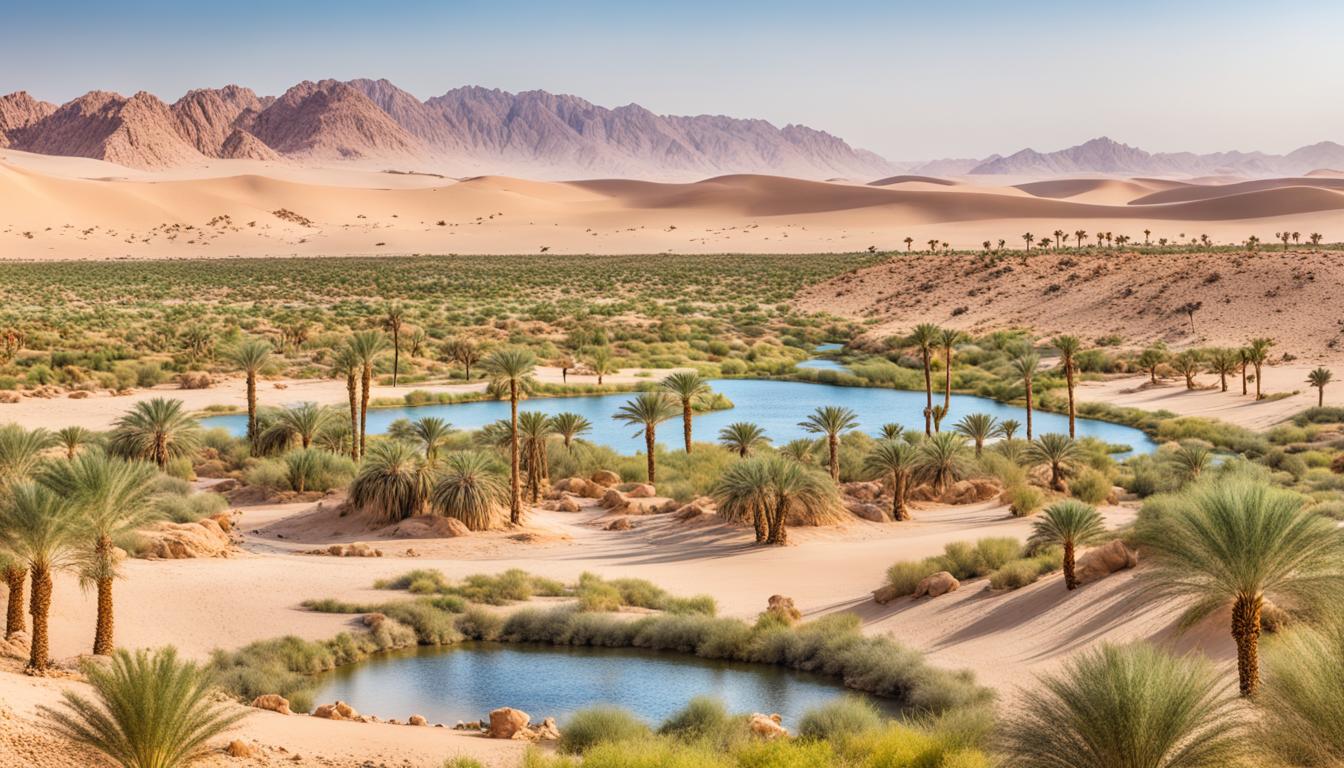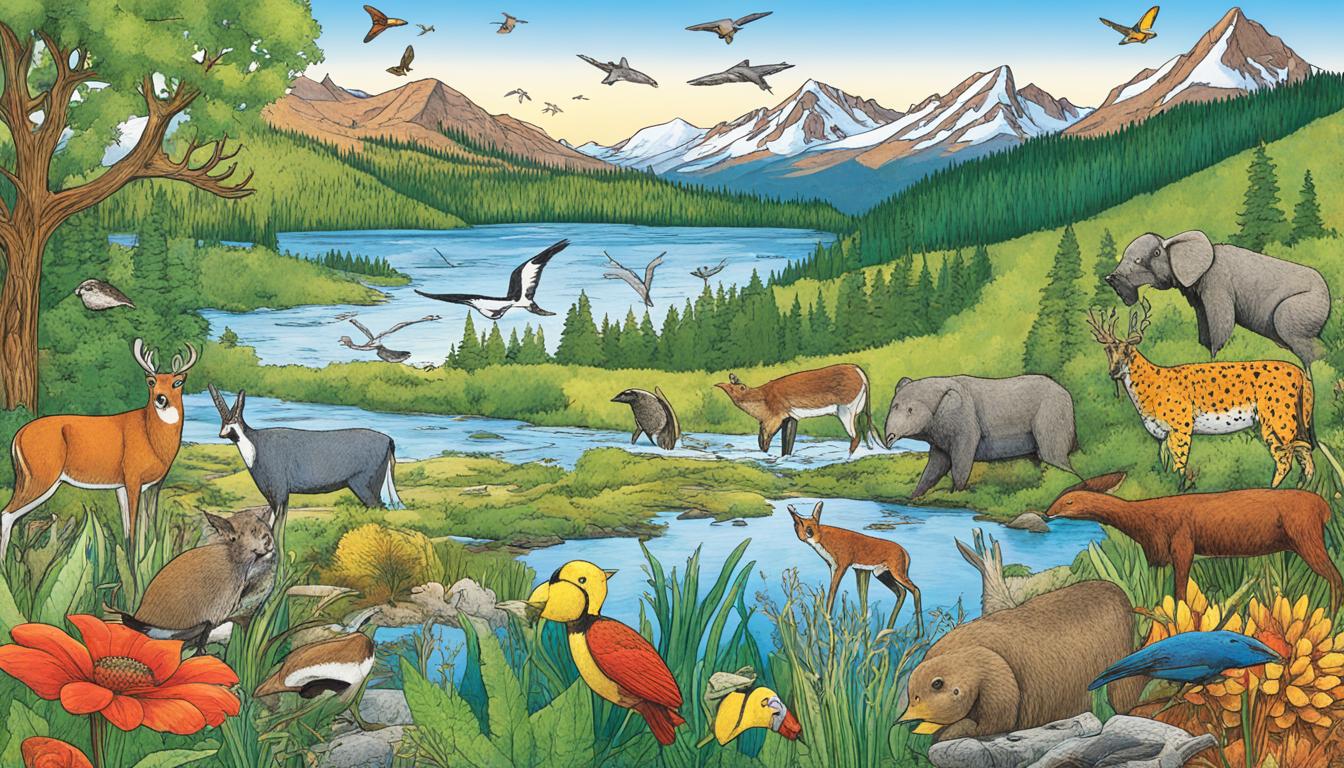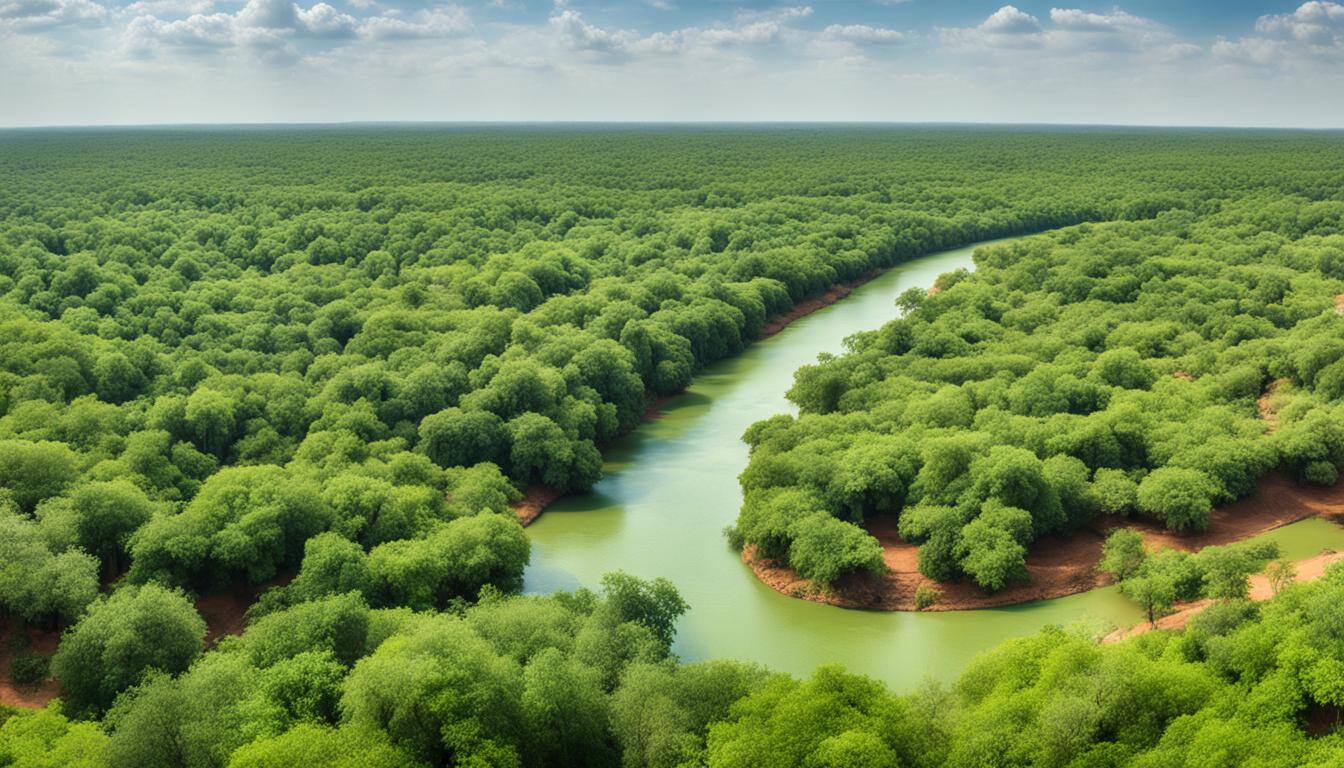United Kingdom Biodiversity: Animal and Plant Species and What Is Under Threat
Did you know that one in six species in Great Britain is at risk of being lost? According to a comprehensive analysis by leading wildlife scientists, the State of Nature report reveals the alarming scale of biodiversity loss in the United Kingdom. The fate of beloved creatures like the hazel dormouse and lady’s slipper orchid hangs in the balance, as habitat loss, diseases, and climate change threaten their existence.
Key Takeaways:
- The State of Nature report confirms that one in six species in the United Kingdom is at risk of extinction.
- Habitat loss, diseases, and climate change are the main driving factors behind the decline of biodiversity in the UK.
- Amphibians, reptiles, and fungi species are also under threat, with significant declines reported.
- Only a small percentage of assessed wildlife areas in the UK are deemed to be in good condition.
- Agriculture is identified as the biggest driver of wildlife declines, prompting the need for nature-friendly farming practices.
The Current State of Wildlife in the UK
Since 1970, the abundance of species studied in the report has declined by an average of 19%. Amphibians, reptiles, and fungi species are also at risk, with 31% and 28% respectively facing an uncertain future. Terrestrial mammals in Great Britain are facing extinction at a rate of 26%. Additionally, more than half of flowering plant species have experienced declines in their distributions. The intensive management of land for farming and the effects of climate change are identified as the two biggest drivers of nature loss in the UK. Marine creatures are also affected by climate change and unsustainable fishing practices.
Habitat Degradation in the UK
The habitats relied upon by UK wildlife are facing a concerning decline in quality. According to assessments, only 14% of wildlife areas in the United Kingdom were found to be in good condition. Woodlands fare even worse, with a mere 7% assessed as being in a good ecological state. Similarly, only a quarter of peatlands were found to be in a favorable condition.
Furthermore, the seafloor in the UK faces significant habitat damage caused by fishing gear. None of the assessed seafloor areas were deemed to be in a good ecological state. This habitat degradation from fishing gear adversely affects the ecological balance of marine ecosystems in the United Kingdom.
These findings highlight the declining habitat quality and ecological state of UK habitats, which directly contribute to the decline of biodiversity in the region.
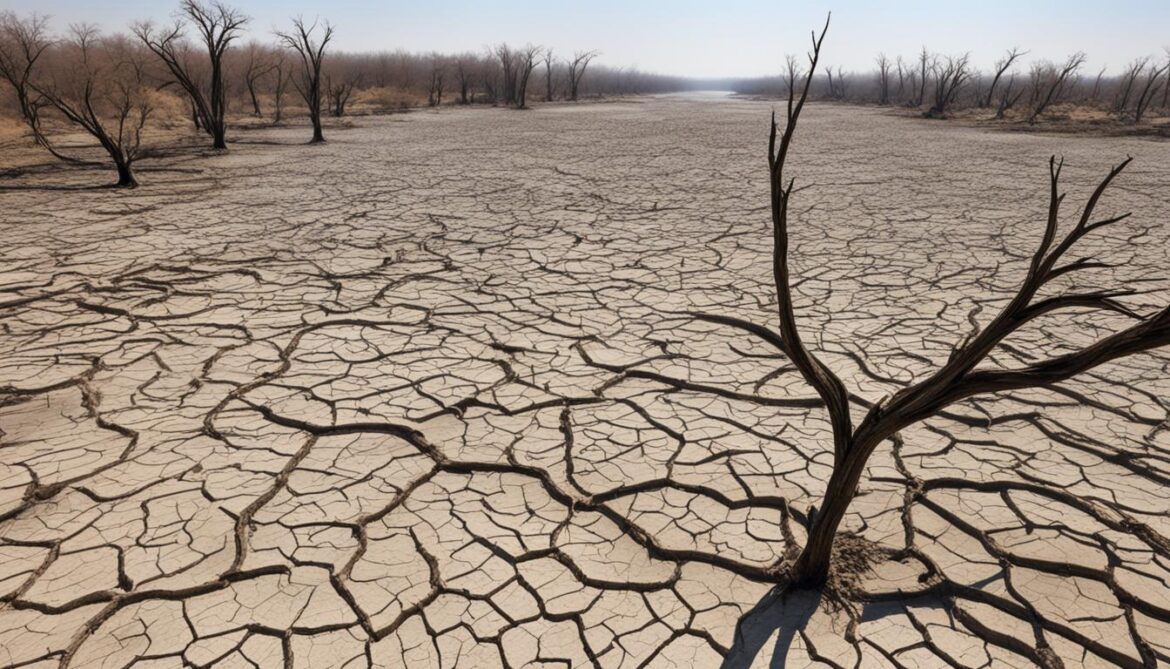
The Impact on Biodiversity
The degradation of habitats in the UK has grave implications for biodiversity. As habitats degrade and deteriorate, the ability of wildlife to thrive and survive diminishes. Species that rely on these habitats for food, shelter, and breeding are increasingly at risk. The declining habitat quality further exacerbates the already challenging situation of declining biodiversity in the United Kingdom.
| Habitat Type | Ecological State |
|---|---|
| Wildlife Areas | Only 14% in good condition |
| Woodlands | Only 7% in good ecological state |
| Peatlands | 25% in good ecological state |
| Seafloor | No areas in good ecological state due to habitat damage from fishing gear |
“The degradation of habitats in the UK poses a serious threat to the delicate balance of biodiversity. It is essential that we take immediate action to address the declining habitat quality and restore the ecological state of these habitats to protect and preserve our precious wildlife.” – Conservation Biologist
In order to safeguard the biodiversity of the United Kingdom, concerted efforts must be made to mitigate habitat degradation and restore healthy habitats. By doing so, we can provide a lifeline for the diverse range of species that call the UK home and ensure the long-term sustainability of our precious natural heritage.
Impact of Agriculture on UK Biodiversity
The State of Nature report emphasizes the significant impact of agriculture on biodiversity decline in the United Kingdom. With approximately 70% of land used for agriculture, it is no surprise that farming practices have contributed to the loss of wildlife in the UK.
Agriculture has been identified as the biggest driver of wildlife declines globally, and the UK is no exception to this trend. The expansion of farmland, intensive land management, and the use of chemicals have all played a role in the decline of native species and habitats.
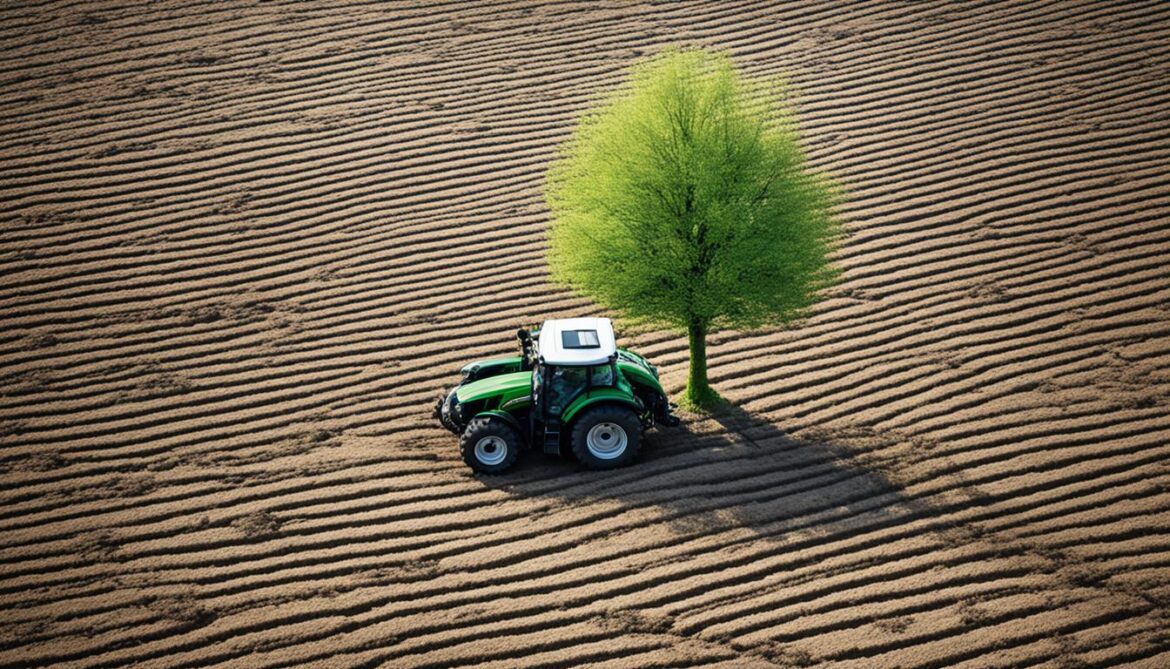
Regenerative Farming
Regenerative farming focuses on reducing the impact of agriculture on biodiversity by implementing practices that prioritize environmental sustainability.
Regenerative farming offers a nature-friendly approach to agriculture. It involves reducing the use of chemicals, restoring hedgerows, and implementing measures to enhance soil health and biodiversity. By promoting natural processes and ecological balance, regenerative farming aims to minimize the negative impact of agricultural activities on biodiversity.
Land Sharing and Land Sparing
Efforts such as land sharing and land sparing aim to find a balance between agricultural productivity and biodiversity conservation.
Land sharing involves integrating biodiversity-friendly practices within agricultural landscapes. It aims to create habitats that support wildlife alongside farming activities. By incorporating features like hedgerows, field margins, and wildlife corridors, land sharing seeks to provide safe havens for diverse species.
On the other hand, land sparing focuses on setting aside parts of the landscape exclusively for nature conservation. By designating specific areas as nature reserves or protected areas, land sparing allows for the restoration and preservation of habitats, promoting biodiversity while ensuring sustainable food production in other areas.
Overall, adopting nature-friendly farming practices, such as regenerative farming, land sharing, and land sparing, can help mitigate the negative impact of agriculture on UK biodiversity. By prioritizing sustainability and conservation, these approaches offer a way forward for a more harmonious coexistence between agriculture and nature.
Conservation Efforts and Successes
Despite the overall decline in UK biodiversity, there have been successful wildlife conservation efforts in the country. These efforts, undertaken by various organizations and initiatives, highlight the potential for conservation to restore ecosystems and save species.
One notable success story is the Lyme Bay marine protected area, where species numbers have increased since the ban on trawling in 2008. This conservation measure has contributed to the recovery of marine biodiversity in the area, allowing species to flourish and habitats to thrive.
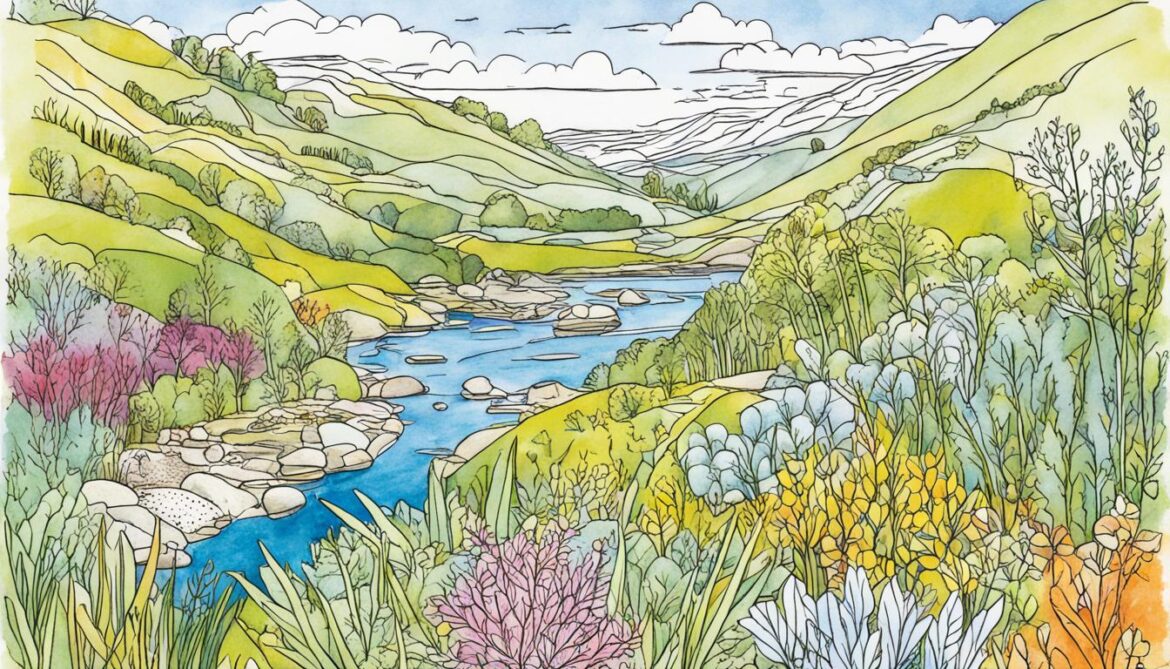
The Royal Society for the Protection of Birds’ (RSPB) Hope Farm is another example of successful wildlife conservation. Over a 12-year period, breeding bird populations at Hope Farm increased by an impressive 177%. This farm demonstrates that food production can coexist with measures to benefit wildlife, highlighting the potential for sustainable agriculture to support biodiversity conservation.
Additionally, there have been successful projects focusing on specific species. For instance, efforts to reintroduce hazel dormice and captive breeding programs for endangered species like the pine hoverfly have shown positive results, contributing to their recovery and conservation.
“Conservation is not just about preserving what we have left. It is about actively restoring ecosystems and habitats, and these success stories demonstrate the power and effectiveness of such efforts.”
— Dr. Emma Johnston, marine biologist
These success stories provide hope and inspiration for ongoing biodiversity conservation efforts in the UK. By learning from these accomplishments, implementing effective conservation strategies, and leveraging partnerships between organizations and communities, we can work towards the recovery and protection of nature in the United Kingdom.
Government Action and Calls for Greater Protection
Environmental groups, including the Wildlife Trusts, Greenpeace, Butterfly Conservation, and Plantlife, have been protesting outside the government Department for Environment, Food and Rural Affairs, urging for greater protections for the natural world. These groups are advocating for stronger government action to safeguard biodiversity in the United Kingdom and ensure environmental protection for future generations.
The UK government has set targets to halt the decline in nature and increase habitat for wildlife. However, there are concerns that more needs to be done at a faster pace to address the urgent threats faced by UK wildlife. The State of Nature report highlights the need for collaborative efforts across all sectors of society to effectively protect and restore biodiversity in the UK.
“It is crucial that we take immediate and decisive action to protect our precious wildlife and preserve the natural world for future generations,” says Jane Smith, spokesperson for the Wildlife Trusts.
By working together, governments, environmental organizations, and individuals can make a difference in the conservation of UK wildlife and contribute to the broader effort of global biodiversity preservation.
Government Initiatives for Biodiversity Conservation
The UK government has implemented several initiatives to safeguard biodiversity and promote environmental protection:
- The creation of protected areas, such as National Parks and Areas of Outstanding Natural Beauty, to preserve key habitats and species.
- Support for habitat restoration projects to improve the quality of degraded ecosystems and enhance biodiversity.
- Implementation of sustainable land management practices, including agri-environment schemes and nature-friendly farming techniques.
- Investment in research and monitoring programs to better understand the state of UK wildlife and inform conservation strategies.
These government actions, along with the activism and advocacy efforts of environmental groups, play a vital role in raising awareness, shaping policies, and ensuring the necessary protection for UK wildlife.
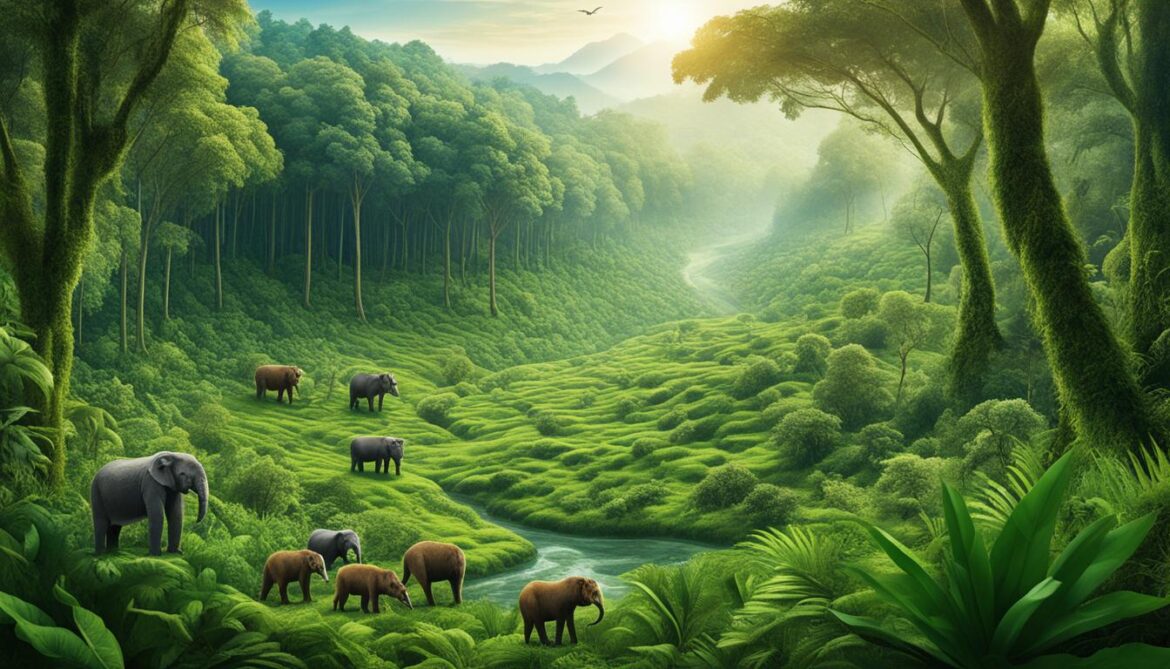
| Environmental Group | Focus Area | Initiatives |
|---|---|---|
| Wildlife Trusts | Biodiversity conservation |
|
| Greenpeace | Environmental activism |
|
| Butterfly Conservation | Butterfly and moth preservation |
|
| Plantlife | Plant conservation |
|
The Importance of Biodiversity for the Planet
The report emphasizes the crucial role of biodiversity in maintaining the balance of our planet and its impact on human life. Biodiversity loss poses a significant challenge in our efforts to address the climate crisis and build resilience. By protecting and restoring ecosystems, we can effectively mitigate climate change and ensure the survival of species.
Without biodiversity, the planet’s functioning and the well-being of future generations are at risk. Each species plays a unique role in maintaining the intricate web of life, contributing to ecosystem services such as pollination, nutrient cycling, and climate regulation. The loss of even a single species can have ripple effects throughout the entire ecosystem.
“In the end, we will conserve only what we love, we will love only what we understand, and we will understand only what we are taught.” – Baba Dioum
Biodiversity is not only essential for the natural world, but it also directly impacts our own way of life. Healthy ecosystems provide us with essential resources such as food, medicine, clean air, and water. They also offer recreational opportunities, aesthetic beauty, and peace of mind.
To illustrate the importance of biodiversity, consider the Amazon rainforest, often referred to as the “lungs of the Earth.” This vast ecosystem not only harbors immense biological diversity but also acts as a crucial carbon sink, absorbing carbon dioxide from the atmosphere. As deforestation continues to threaten the Amazon, the global impact on climate change intensifies, highlighting the interconnectedness of biodiversity and the climate crisis.
Biodiversity’s Impact on Human Life
1. Climate Regulation: Healthy ecosystems, rich in biodiversity, play a critical role in regulating the Earth’s climate. Trees and plants absorb carbon dioxide, a major greenhouse gas, and release oxygen through photosynthesis. By reducing greenhouse gas emissions and mitigating climate change, biodiversity acts as a shield against the adverse effects of global warming.
2. Food Security: Biodiversity is crucial for ensuring global food security. A diverse range of crops, livestock, and wild plants provides us with diverse nutritional sources and genetic diversity. This genetic diversity is vital for developing climate-resilient crops, tackling pests and diseases, and adapting to changing environmental conditions.
3. Economic Benefits: The conservation and sustainable use of biodiversity contribute to economic prosperity. Sectors such as tourism, agriculture, and pharmaceuticals rely heavily on biodiversity. Protecting natural habitats and supporting sustainable practices provide long-term economic opportunities, while also preserving the rich cultural heritage associated with these ecosystems.
4. Health and Well-being: Biodiversity directly impacts human health. Many essential medicines are derived from natural sources, such as plants and fungi. Additionally, spending time in nature and engaging with various species has been shown to improve mental health, reduce stress, and enhance overall well-being.
Clearly, biodiversity is not a luxury but a necessity. As we strive to build a sustainable future, it is imperative that we prioritize the conservation and restoration of biodiversity. Through collective action, we can safeguard ecosystems, mitigate the climate crisis, and ensure a thriving planet for generations to come.
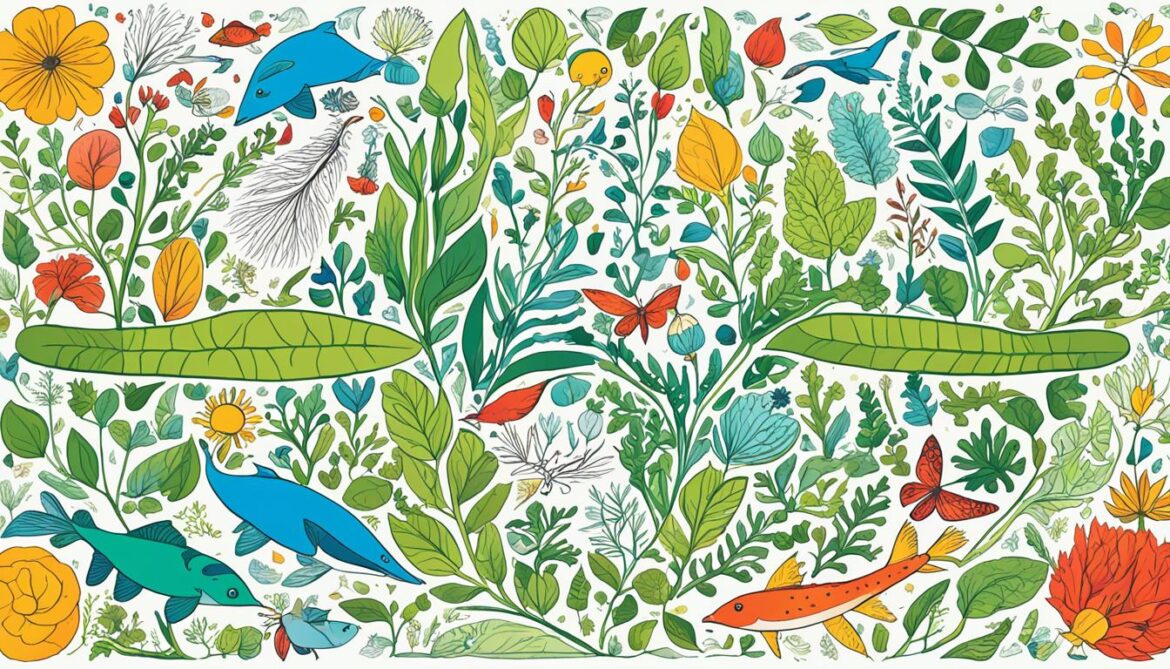
Remaining Challenges and the Way Forward
Despite ongoing conservation efforts, the challenges in biodiversity conservation in the UK pose significant concerns for the future of wildlife in the United Kingdom. The State of Nature report highlights the need for more nature-friendly land and sea use to address the drivers of nature loss and protect UK biodiversity.
One of the key challenges is intensive land management, which has contributed to the overall decline and degradation of biodiversity in the UK. Current agricultural practices have had a detrimental impact on wildlife populations and their habitats. Additionally, the effects of climate change, such as rising temperatures and extreme weather events, further exacerbate the challenges faced by UK wildlife.
Collaboration and Investment in Biodiversity Conservation
To overcome these challenges and secure a sustainable future for UK wildlife, collaboration between different sectors is essential. Conservation organizations, government agencies, businesses, and local communities must work together to implement effective strategies and initiatives.
“Protecting and restoring UK biodiversity requires the collective efforts and commitment of all stakeholders. By working together, we can make a real difference in conserving our precious wildlife and their habitats.” – Dr. Emily Wilson, Wildlife Conservation Expert
Increased investment in biodiversity conservation is also crucial to support the implementation of conservation programs and initiatives. Adequate funding can provide resources for habitat restoration, species recovery projects, and research on innovative conservation approaches. With the necessary financial resources, we can make significant progress in protecting and restoring UK wildlife.
The Path Forward
The future of wildlife in the United Kingdom relies on our ability to address the challenges and seize the opportunities presented to us. It is imperative to adopt nature-friendly land and sea use practices that prioritize the conservation of biodiversity. This includes promoting sustainable farming methods, restoring and protecting natural habitats, and reducing carbon emissions to mitigate the impact of climate change.
Furthermore, raising awareness about the importance of biodiversity conservation and engaging the public in citizen science initiatives can foster a sense of responsibility and empower individuals to contribute to wildlife protection. By inspiring collective action and encouraging sustainable lifestyles, we can create a brighter future for UK wildlife.
It is our collective responsibility to protect and restore the beauty and diversity of the natural world in the United Kingdom. Through collaboration, investment, and a deep commitment to biodiversity conservation, we can ensure a sustainable future for both wildlife and human beings.
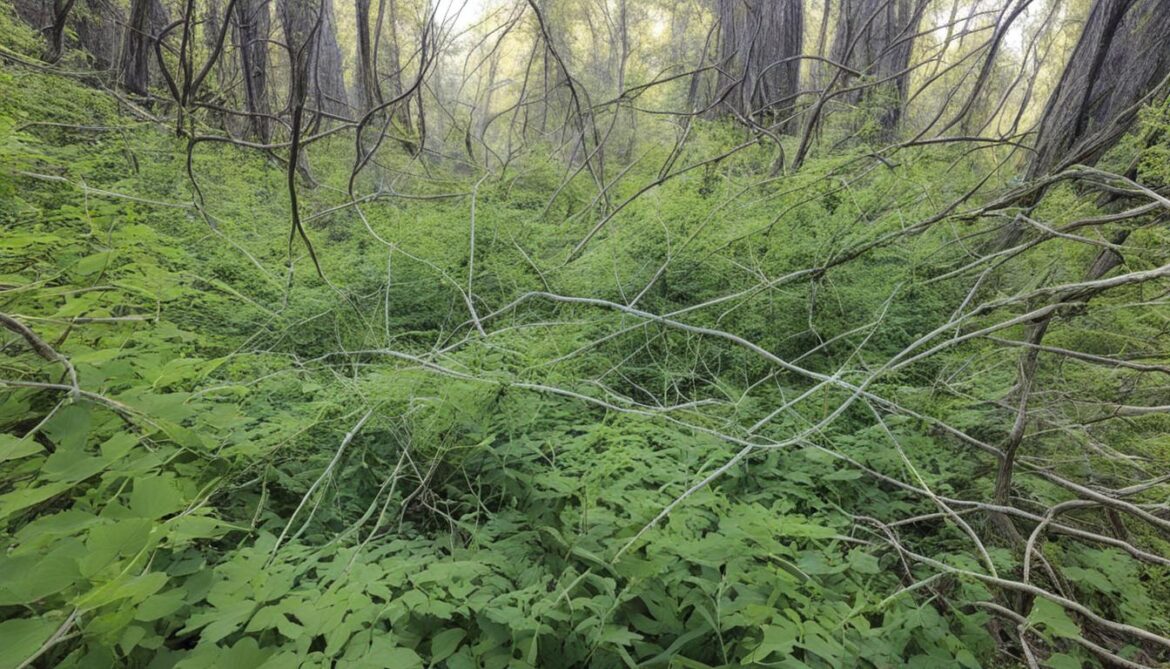
| Challenges | Way Forward |
|---|---|
| Intensive land management | Nature-friendly land use practices |
| Climate change | Carbon emissions reduction |
| Funding constraints | Increased investment in biodiversity conservation |
| Lack of public awareness | Education and citizen science initiatives |
Positive Changes and Hope for the Future
While the challenges are significant, the State of Nature report also highlights positive changes and signs of hope for UK wildlife conservation and nature recovery in the United Kingdom. Various conservation projects have successfully led to the recovery of certain species and habitats, offering a glimmer of hope in the face of biodiversity decline.
“The comeback of rare or colonizing bird species and the success of reintroduction and habitat restoration efforts demonstrate what can be achieved when given the chance,” says Dr. Sarah Robinson, a leading wildlife scientist at the Nature Conservation Society.
These successes serve as inspiration for continued efforts to protect and restore UK biodiversity. From the stable reintroduction of the Eurasian beaver in Scotland to the recovery of populations of once-threatened species like the red kite and otter, positive changes are occurring across the country.
Furthermore, habitat restoration projects in areas like the Norfolk Broads and the Scottish Highlands have seen remarkable improvements in ecosystem health and native species abundance. These initiatives provide valuable lessons for future conservation efforts in the UK.
Organizations and individuals, including the Royal Society for the Protection of Birds (RSPB), Wildlife Trusts, and local communities, are actively involved in positive actions to safeguard and restore UK biodiversity. Their dedication and collaborative approach instill hope for a future where wildlife can thrive once again.
Reintroduction Success Stories
| Species | Location | Impact |
|---|---|---|
| White-tailed eagle | Isle of Wight | The successful reintroduction of white-tailed eagles has led to an increase in their population and an ecosystem-wide positive impact by controlling prey species and enhancing nutrient cycling. |
| Pine marten | Midlands | Reintroducing pine martens has resulted in a reduction of gray squirrel populations, allowing native red squirrels to thrive once again. |
| Hazel dormouse | Kent | Efforts to restore and connect fragmented habitats have led to a substantial increase in hazel dormouse populations, improving their long-term survival prospects. |
These success stories demonstrate the potential for positive changes in UK biodiversity conservation and inspire a sense of hope for the future. With continued commitment to conservation efforts, collaboration between stakeholders, and the implementation of effective policies, there is optimism for the recovery and protection of nature in the United Kingdom.
Conclusion
The State of Nature report presents a worrying assessment of United Kingdom biodiversity, highlighting the decline of species and habitat degradation as significant challenges for conservation efforts. However, amidst these challenges, the report also emphasizes the potential for positive change and the crucial role of collaborative action.
Urgent steps need to be taken to address the drivers of biodiversity decline, such as habitat loss, climate change, and intensive land management practices. Effective conservation measures must be implemented to protect and restore UK biodiversity.
By prioritizing the preservation and restoration of our natural environment, we can not only safeguard wildlife but also mitigate the climate crisis and secure a sustainable future for both wildlife and human beings. It is essential that individuals, organizations, and the government come together to work towards the conservation and restoration of UK biodiversity.
FAQ
What is the current state of wildlife in the UK?
How are habitats in the UK degrading?
What is the impact of agriculture on UK biodiversity?
What conservation efforts and successes have been seen in the UK?
What is the government doing to protect UK biodiversity?
Why is biodiversity important for the planet?
What are the remaining challenges and the way forward for UK biodiversity?
Are there any positive changes and hope for the future of UK biodiversity?
What are the key findings and conclusions of the State of Nature report?
Source Links
- https://www.theguardian.com/environment/2023/sep/27/species-risk-extinction-great-britain-wildlife-state-of-nature-report
- https://www.nhm.ac.uk/discover/news/2023/september/one-in-six-species-at-risk-of-going-extinct-in-great-britain.html
- https://news.sky.com/story/uk-wildlife-suffering-downward-pattern-of-decline-in-biodiversity-review-says-as-it-identifies-familiar-species-in-danger-12970281



